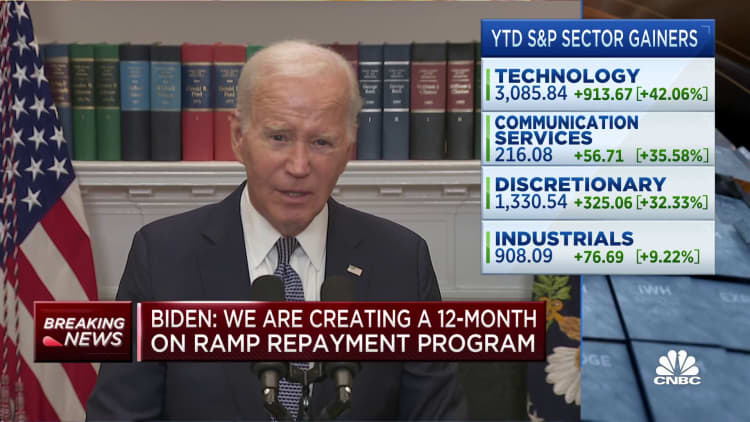When federal student loan payments finally restart in the fall, the Biden administration will offer borrowers some elbow room.
The U.S. Department of Education will institute a 12-month "on ramp" to repayment, which will run from Oct. 1, 2023, to Sept. 30, 2024. During that period, borrowers will be shielded from the worst consequences of missed payments.
Borrowers may need that leeway: The Consumer Financial Protection Bureau recently warned that roughly 1 in 5 student loan borrowers could struggle when their payments resume.
Here's what to know.
Extra protections follow Supreme Court decision
President Joe Biden announced the provision easing borrowers back into repayment on Friday afternoon, hours after the Supreme Court struck down his student loan forgiveness plan.
Before the ruling, the Biden administration said that resuming student loan payments without being able to carry out its debt forgiveness could trigger a historic spike in defaults and delinquencies.
More from Personal Finance:
Term life insurance is often best but most buy another kind
Your 401(k) plan may be worsening climate change
What Supreme Court case could mean for wealth tax ideas
"Even if the risk from the virus has diminished, the financial fallout has not," said Persis Yu, deputy executive director at the Student Borrower Protection Center, an advocacy group.
In an acknowledgment of the challenges that could lie ahead for borrowers, Biden said missing a payment won't lead to many of the usual penalties for a year after the bills resume. In addition, the president said his administration would try to find another way to deliver on student debt forgiveness.
This aid is not another payment pause extension
Former President Donald Trump first announced the stay on federal student loan bills and the accrual of interest in March 2020, when the coronavirus pandemic hit the U.S. and crippled the economy. The pause has since been extended eight times.
The latest announcement by Biden is not another extension of that policy.
Even if the president wanted to prolong the relief, the recent bipartisan agreement to raise the federal debt ceiling included a provision that officially terminates the more than three-year-long pause at the end of August. (Borrowers' official due date will depend on their loan terms.)

However, borrowers will be spared from many of the usual consequences of missing a payment until October of next year.
For example, loans will not go into default and delinquencies will not be reported to credit reporting agencies, said higher education expert Mark Kantrowitz. Late fees won't be charged, either.
"The 12-month on-ramp is similar to a forbearance in many ways," Kantrowitz said.
But as is the case with a forbearance, interest will continue accruing on your debt while you don't make payments. As a result, Kantrowitz recommends borrowers start repaying their bills, if they can.
"Doing otherwise will eventually hurt them," he said.


